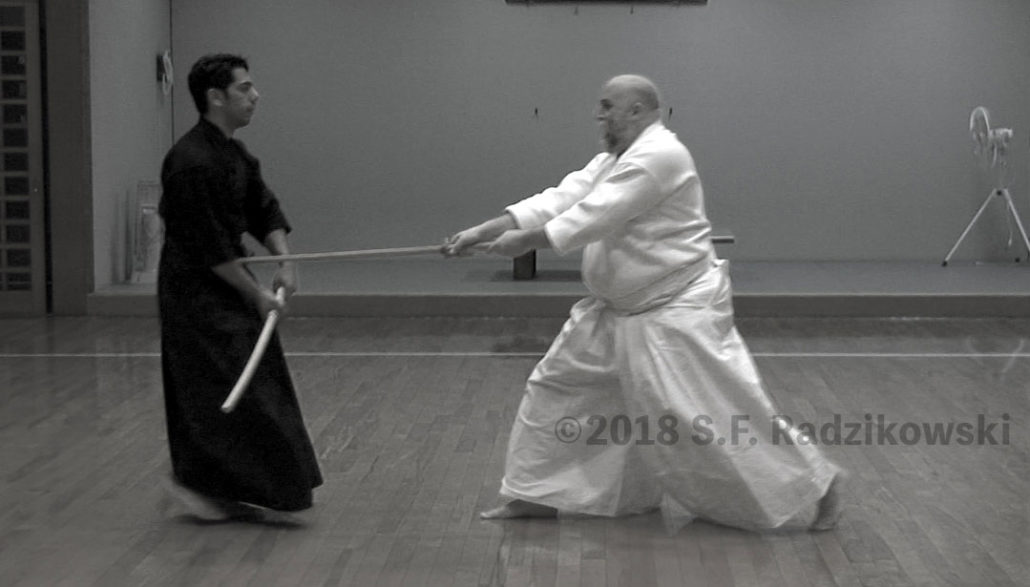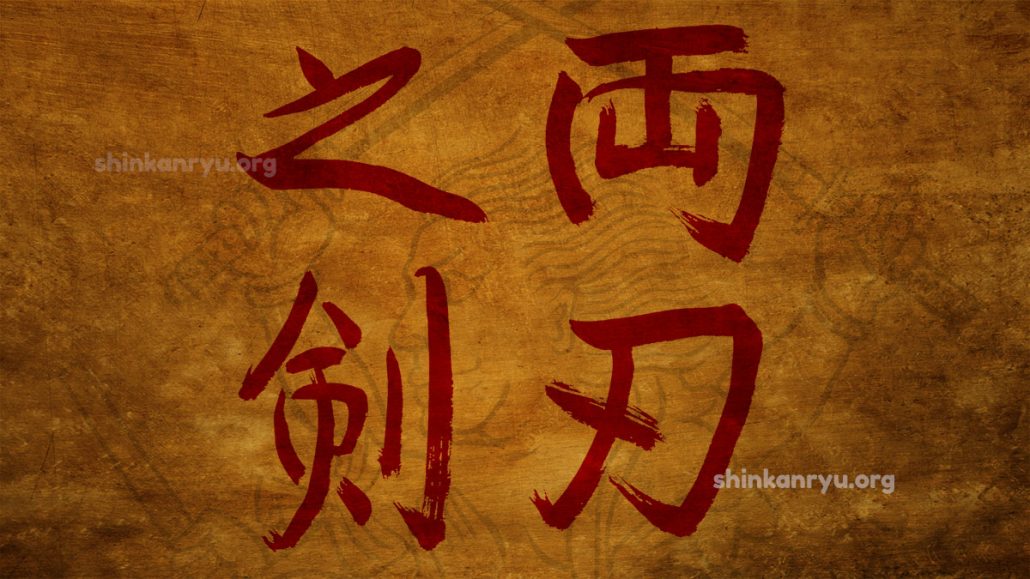Bujutsu Kata
Training in martial arts can be done in different ways. One of the tried and true methods in Japan is the kata 形 (shape) or 型 (model). Combat systems in Japan have used the kata as an instruction tool from at least 1200 AD as a way to train the bushi or samurai among their domains and training camps. Kata in martial arts was developed to train both the mind and body. Psychosomatic training is integral in bujutsu. Kata training is a rehearsed set of movements with a lot of detail and depth contained in them. Kata can be done solo or paired. Although choreographed kata can be greatly modified by small adjustments of timing and distance.
There are many combat-oriented schools from the time of the samurai still extant today. We often refer to these schools as Koryu 古流. Old Styles. Koryu mainly relies on the kata as the teaching method.
What Is Koryū?
I would like to briefly define Koryū as it differs from modern Japanese martial arts in a few ways. We can define it solely by its age. Most agree that styles invented after 1868 fall under the umbrella of modern (Gendai 現代) budo. Everything before 1868 is Koryū.
This is a shallow definition and presents a bit of a problem in identification because some arts before this time frame and after do not exactly fall into the arts that were designed for fighting and taking lives; combative arts (Bugei 武芸).
Another means to categorization is that modern budo places importance in an order of aesthetics, character discipline, and correct morality. The latter being the most important. Bujutsu, on the other hand, places combat effectiveness as its primary ambition with discipline and correct morals falling in second and third. If at all.
The problem here is that some schools founded after 1868 can have the same functions.
What makes Koryū different from modern arts in Japan?
What most classical schools have in common is using paired kata as a teaching method. And it is the reliance of this kata as a training method that helps distinguish the classical Japanese Martial arts from the budo forms it gave birth to. In most modern budo the kata is looked at as a bit of a museum piece. Something not so dynamic and useful for martial training.
However, for the medieval warriors of Japan, and the modern Koryu practitioner the kata was, and is, a very valuable and effective tool in teaching the techniques of a particular style and preparing the mind of the person for combat engagement within a battle or duel.
Kata teaching allows students to learn and understand what is more combat effective. Though some will view this as not true. We should consider that the movements themselves are not always the focus. When we watch a kata performed we tend to lock onto the gross movements and shapes. But what is within this space is the behavior that makes up the actual style. This behavior is what is learned through performing and studying kata. This behavior is the ideal to be understood. Learning kata is a psychosomatic endeavor. The mind, breath, and body need to be cultivated and trained.
The bushi were trained to deal with battle and the lifestyle of a warrior.
We should not separate the warrior from the battle. Even outside of the war-zone there were dangers for the bushi, therefore there was an emphasis on mental, physical and spiritual training.
That death is the way of the samurai is not only that one gets killed, but that one is killing others. Death is impermanence and that is the main issue for a warrior. Nothing remaining the same is a crucial idea in a grand battle or even a duel. This is an important aspect and concerns the spiritual training for bushi. Having this power or ability to kill and knowing when to use it allows the warrior to show compassion or mercy.
These morals are honed by interacting with others in training. Training with others is really the only effective way to gain skill in dealing with attacks.
Modern iaido training while very interesting and in-depth is not always concerned with the important facets of sword combat.
Awareness, timing, and distance are integral aspects of weapon combat. We don't find this in solo practice of which most modern schools are made up of. The kata, of course, contains the training for all three. The opponent with serious intent poses a great danger. Feeling safe does not prepare the person for the mental stress arising from danger in combat.
During my Kendo training, in the beginning, my dojo-mates felt that free practice was more interesting and effective as a learning tool. I thought it was interesting as the free exchanges provided me with an opportunity to increase my skill in understanding maai 間合い and timing (combative distance intervals). My idea was that its a great way to develop better combat skills. I also felt that basics practice, where your partner is doing a prescribed strike and you are countering it in some way, similar to a kata form, was very effective in learning. After studying koryū kenjutsu I realized that the kata standard was actually more effective in learning combat effective styles. The sword was coming much faster and with more speed and power, I also wasn't wearing protective equipment. That feeling that “yeah sure I will get hit but it's ok.”, wasn't there anymore. No more false security. Now if I made a mistake I was in for a moderate to serious injury. In fact in many cases that serious injury can be death. I believe the combative mindset is much stronger within kata than in free practice. Within the kata, there is a multitude of chances to increase danger and stress. The choreographed nature also allows breathing room for the student to contemplate more deeply about many aspects of the technique.
Kata might be pre-arranged but it is not always predictable.
Technological Advances
Widespread use of protective equipment was also not sought out and used until much later in bujutsu history. Weapons such as the fukuro shinai were in use around the 16th century. As well Maniwa Nen-ryū was using protective headgear around the 17th century. Widespread use of ‘sparring armor’ become more popular as the fighting classes had no more wars, and there was now a way to have matches without risk of death and serious injury. This is the birth of a martial sport that we know of today as Kendo. Towards the end of the 18th century, many schools incorporated fighting with protective equipment into their curriculum. These schools had much higher enrollments than schools centered on the age-old tradition of kata based teaching.
The thrill of fencing is something that pervades the world of martial arts even today. Kendo, and Judo have far higher enrollments than classical arts of Kenjutsu and Jujutsu.
This is of course not the only reason. But it is a large enough reason not to dismiss it.
Kata is often looked at as static and impotent, however, training with knowledgeable people kata practice is extremely intense and pragmatic and effective in training someone in the arts of classical Japanese warfare. This practice is not solely tied to the age of the Samurai. The modern military also uses kata in combat classes as well. Kata can be viewed with a dismissive attitude, but as most things are a bit old we should look keenly at it and understand it deeply before throwing it out as a useless artifact from the past.

ラジカスキー真照
館長Saneteru Radzikowski is the head sword instructor of Shinkan-ryū Kenpō. He lives and teaches Iaijutsu and Kenjutsu from Nara, Japan.
Martial Arts and The Path: Strive for the truth
If you study the way and path 道, then you should understand the truth correctly....
Duping The Gaijin – Martial Arts Fraud
Some Japanese schools or individuals wish to capitalize on the ignorance of non-Japanese martial artists...
What Value Is In Martial Arts Training?
Someone asked, “What value is there in martial arts training?” I reflected, what do I...
Saya no uchi
I train to strike correctly. I perform keiko to understand the angles of my sword....
Impermanence, The Mind, and the Truth
After every meditation session my teacher, with his eyes still closed, would softly speak in...
Pain & Training In The Martial Arts
Pain & Training Pain is a universal dilemma. Especially for those in sports or martial...
Speed, Martial Arts and Samurai Theater
What’s the difference between bugei 武芸 (martial arts) demonstrations and stunts? People are awed by...
The Sword With Two Edges
Today I decided to write the four kanji compound of morohanotsurugi. In English, we might...
Practice. Time Is Fleeting
In #budo as well as life, in general, we should avoid wasting time. We need...
Katate Tsuki-One handed Thrust Iaijutsu
[fusion_builder_container hundred_percent="no" equal_height_columns="no" menu_anchor="" hide_on_mobile="small-visibility,medium-visibility,large-visibility" class="" id="" background_color="" background_image="" background_position="center center" background_repeat="no-repeat" fade="no" background_parallax="none" parallax_speed="0.3"...
Be Thankful.Be Earnest In Bujutsu & Life
Be thankful for your mistakes, failures, and blunders. They are your own teacher reminding you...
Munen Muso And Mushin The Warriors Mind
What is the difference between munen and mushin? These concepts outline the ideal mental state...
Don’t Fall Into The Honey
You only have a little bit longer to live. The end is coming, whether in...
Martial Arts Creator Origin Myths of Japan
Japanese Koryū Creator myths; becoming enlightened and making up a whole martial arts system. Some...
How To Avoid Training Pitfalls In Martial Arts
Beware The Rabbit Holes. I want to talk about some pitfalls of martial arts training....
How to learn kenjutsu?
How to learn kenjutsu? Learning anything as profound as a martial art needs a teacher....
The Martial Arts Heart
Budo values reflection and compassion. When these are not present it is hard to develop...
Martial Arts Breathing
The spirit of the sword is the breath. Breathing Physiology What’s so crucial about martial...
Honesty and the Martial Arts Hermit. Being a good budō teacher and student.
When people want to find a martial arts teacher, do they often think of mister...
Mitorigeiko Special Practice
Present and switched on The method of critically watching practice is commonly referred to as...
7 Year Anniversary of Online and In-person Sword Learning
Today marks a significant milestone in our journey — the 7th Anniversary of Shinkan-ryu Kenpo!...
Secrets of Swordsmanship: In-yō. Ying & Yang
I wanted to talk about IN-YŌ 陰陽, or more commonly known as yin & yang....
©2018 S. F. Radzikowski


























